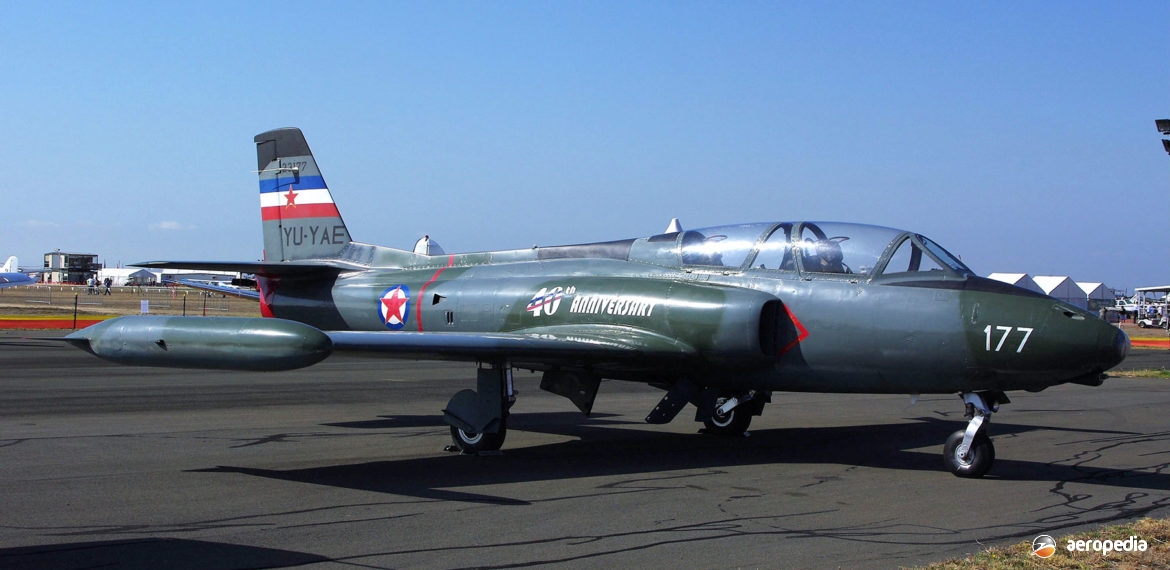Photograph:
Soko Galeb YU-YAE / VH-YUF (c/n 23109) at Avalon, VIC in March 2009 (David C Eyre)
Country of origin:
Yugoslavia
Description:
Two-seat military trainer / light attack aircraft
Power Plant:
One 2,500 lbst [licence-built] Bristol Siddeley Viper II Mk 22-6 turbojet
Specifications:
- Wingspan: 11.62 m (38 ft 1½ in)
- Length: 10.34 m (33 ft 11 in)
- Height: 3.28 m (10 ft 9 in)
- Wing area: 19.43 m² (209.15 sq ft)
- Max speed at 6,200 m (20,340 ft): 812 km/h (505 mph)
- Max speed at sea level: 756 km/h (470 mph)
- Max cruising speed at 6,000 m (19,685 ft): 730 km/h (453 mph)
- Ferry range with wing tip tanks: 1,242 km (772 miles)
- Endurance: 2 hrs 30 mins
- Empty weight: 2,620 kg (5,776 lb)
- Loaded weight: 4,300 kg (9,480 lb)
Armament:
Wing hard points able to carry two 100 kg (220 lb) bombs; up to six 57 mm rockets; two 12.7 mm (0.50 in) machine guns installed in the nose
History:
The G-2A Galeb (Seagull) was the first indigenous jet-powered military trainer designed and placed in production in Yugoslavia. For the project a team of Yugoslavian engineers at the Aeronautical Technical Institute in Belgrade (Vazduhoplovno Tehnicki Institut) began the design of a new training and light attack aircraft to replace a number of aircraft which had been used for training purposes. Work on the project commenced in 1957 and the prototype, built at the SOKO facility in Mostar in Bosnia Herzegovina (then part of Yugoslavia) was first flown on 9 May 1961. Following trials, production commenced in 1964 and first deliveries were to the 105th regiment at Zemunik airbase, a training unit. The type received the military code N-60 and about that time a G-2 was demonstrated at the Farnborough and Paris Airshows.
The aircraft was a conventional low-wing monoplane, but, compared to western trainers, was un-pressurised and did not have as extensive an avionics fit-out. It was able to operate from grass strips and the engine intakes were designed to prevent particle ingestion. It received some development, the next model having an up-rated Viper 532 engine, which in due course became the prototype of the Galeb 3, this prototype being used as the development aircraft for the IJ-1 Jastreb (Hawk), this variant itself being produced in two main models, the single-seat J-1 and the two-seat IJ-1. The J-21 Jastreb was a strike aircraft based on the G-2, which was ordered to replace the Republic F-84G Thunderjet but the J-21 was not cleared to operate from grass strips.
The Galeb entered Yugoslavian service in 1965 and 130 were supplied for training duties at the air force academy and at fighter and ground attack schools. Total production was 129 J-21s, 38 IJ-21s, 16 NJ-21s, and 112 G-2AEs with up-rated avionics and air-conditioning. A further 34 were supplied to Libya and six were supplied to the air force of Zambia. Up to that time it was the most successful product of the Yugoslavian aviation industry.
Eventually the Galeb was developed to the G-4 Super Galeb, the prototype of this model flying for the first time on 17 July 1978. Serials known to be allotted to the series include: prototypes 23001 to 23003; G-2A Galeb – 23101 to 23199, 23205 to 23207, 23211 to 23212, 23253, 23256, 23264 and 23274; J-21 Jastreb 24101 to 24116, 24120 to 24159, 24160, 24164, 24172, 24201 to 24220, 24251 to 24280, 24284, 24291, 24301 to 24308; RJ-1 and IJ-21 23401 to 23430, 24451 to 24458; and IJ-1 and NJ-21 23501 to 23516.
During the civil war which took place in the region in the late 1980s Galebs flew a number of sorties, mainly attacking targets in Croatia. After the war the new Republic received a few survivors, the Dayton Peace Agreement specifying the number of combat aircraft had to be reduced to 155, and many were scrapped. A number were refurbished and put into service with a training unit. These were attached to the 251st Fighter Bomber Squadron, part of the 172nd Aviation Brigade, which was based at Montenegro in Serbia. In 1988 NATO forces operating under the code name Allied Force commenced a bombing campaign in Kosovo in an attempt to stop the civil war then proceeding in Yugoslavia, the NATO forces attempting to destroy the country’s air defences. Many Galebs were destroyed on the ground at their air force bases.
One was operated for a period with the civil registration YU-YAB (serial 23170) and was flown to the United Kingdom. A few survive in civil guise in Europe. Some survivors were operated by the Serbian Air Force for a time but in recent years the type has been retired and offered for sale, a number of examples being obtained by warbird enthusiasts in the United States and restored for civil use.
In late 2004 a Galeb G-2A (c/n 23109 – ex N109PP), which was built in 1965, was imported from the United States, arriving at Woodbourne, NZ. After some refurbishment it was flown for the first time in March 2005 and demonstrated at the Classic Fighters Airshow at Omaka at Easter that year but was not registered in New Zealand. Subsequently it was offered for sale and in October 2005 exported to Australia where it underwent some work at Tyabb, VIC. It became VH-YUF on 15 September 2009 to Jeffrey Knott of Heathmont, VIC and has been based at Lilydale, VIC.
A further example arrived in Australia in early 2009, this being a Model G-2A registered YU-YAE (c/n 23177) which commenced operations from West Sale, VIC. It later became VH-YUE on 30 September 2009 to its owner Jeffrey Knott at Heathmont, VIC. The latter aircraft was cancelled from the Civil Aircraft Register in February 2016, being exported to Serbia.

